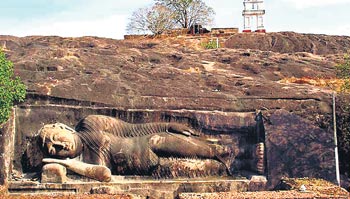
Thanthirimale: Amidst pilgrims and serene statues, a sacred city will be bornIn the history of Thanthirimale, 2007 will be a landmark year. Amidst the serenity of worship of thousands of pilgrims who will flock there this Poson Poya, Minister Dinesh Gunawardene will declare the area a Sacred City. The Minister will present documents to this effect to Chief Incumbent Ven. Thanthirimale Chandraratana Thera.
Chief Minister of the North Central Province Berty Premalal Dissanayake will then lay the foundation stone for the new Sangawasa (monastery) and a museum for artefacts of the area. Wijeya Newspapers will hold their annual Aloka Pooja at Thanthirimale on June 30 and July 1 with staff members participating in the activities. They will donate uniform material and school stationery supplies to the Daham Pasal children and teachers. Dansalas will be held on June 30 and July 1 and 2. The lighting up of Thanthirimale is being done under the Lankadipa Poson Poya programme.Much work has been done at Thanthirimale to accommodate pilgrims, with Rs. 1240 million being spent on building restrooms. This facility too will be declared open by Minister Berty Premalal Dissanayake. The history of Thanthirimale dates to the 6th century BC, when Prince Vijaya and his men set foot on the island at a spot that came to be called Thambapanni, meaning bronze sand. After meeting Kuveni, the princess of an indigenous tribe, and settling there, Vijaya and his group moved further inland to build a kingdom. The route they are believed to have taken was along a river named Malwathu Oya. The leaders of Vijaya’s group proceeded along the river and when a chief found a suitable place his team stopped there and built a village. A chief called Upathissa built Upathissagama while chief Anuradha's village was named Anuradhagama. These were the first settlements of this country. Vijaya’s men gradually expanded their territory along the Malwathu Oya, and thus began the written history of Sri Lanka. Upathissagama was close to Thanthirimale. Anuradhagama is today known as Anuradhapura. In the 3rd century BC Thanthirimale was known as Thiwakka Bamunugama after the local ruler Thiwakka who had the privilege of hosting the royal procession carrying the sacred Bodhi sapling brought to the island by Buddhist nun Sanghamitta. As a token of appreciation a shoot of the Bo sapling was given to Thanthirimale and can still be seen there today. Evidence that there had been a civilization before the arrival of Vijaya is cited by many experts. In 1909 John Still discovered archaeological evidence from the surface layer of the large cave located in the vicinity of the Thanthirimale temple. "…. in prehistoric times it must have been the refuge of human beings, for in it I found fragments of cherts and a piece of crystal. These were not in any sense implements, but they may have been waste chips thrown away while implements were being made for they are of material quite foreign for their surroundings," he wrote. Thanthirimale is also well known for its Buddha statues. In the northern slope of the rock is carved the reclining Buddha statue that is 45 feet long. The Samadhi statue carved in a cave is 2.16 metres high. The statue is decorated with the images of two lions and two deities. The stone seat of the Buddha is also ornamented with lion images. Stone pillars in front indicate a structure like a roof, made to cover the statue. There are four roughly marked images on either side of the statue. Experts believe that these unfinished images indicate that the artist had to abandon the task suddenly. The shrine of the Thanthirimale temple was begun in the 1970s and contains many beautiful wall paintings. It was the late Vimalagnana Thera who pioneered the construction of the Thanthirimale Raja Maha Viharaya. |
|| Front
Page | News | Editorial | Columns | Sports | Plus | Financial
Times | International | Mirror | TV
Times | Funday
Times || |
| |
Copyright
2007 Wijeya
Newspapers Ltd.Colombo. Sri Lanka. |
